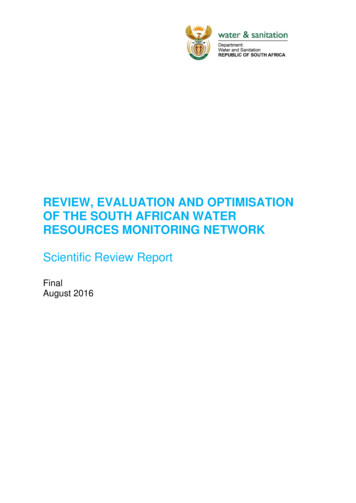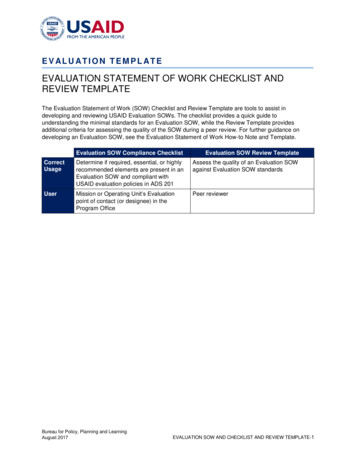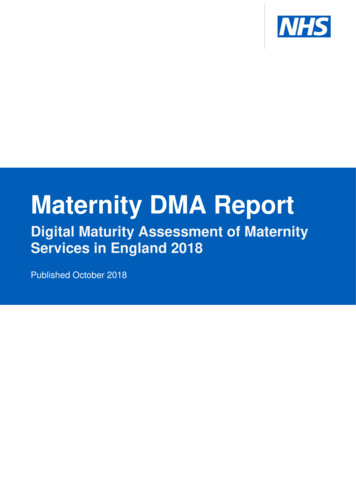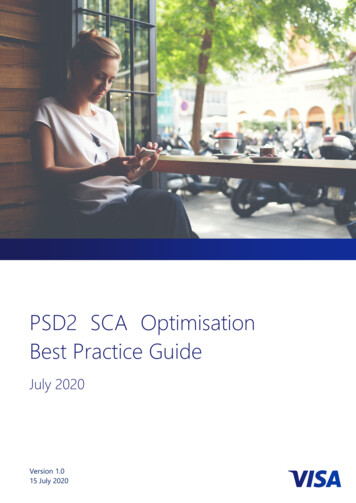
Transcription
REVIEW, EVALUATION AND OPTIMISATIONOF THE SOUTH AFRICAN WATERRESOURCES MONITORING NETWORKScientific Review ReportFinalAugust 2016
REVIEW, EVALUATION AND OPTIMISATIONOF THE SOUTH AFRICAN WATERRESOURCES MONITORING NETWORKSCIENTIFIC REVIEW REPORTAugust 2016PREPARED BY:AECOM SA (Pty) LtdPO Box 3173PRETORIA0001CONTACT PERSONMr JD Rossouw (Study Leader)Tel No: 27 (0) 12 421 3500PREPARED FOR:Chief Directorate: Water Information ManagementDepartment: Water and SanitationPrivate Bag X313PRETORIA0001CONTACT PERSONMr M MusaririTel No: 27 (0) 12 336 7500
Review, Evaluation and Optimisation of the South African Water Resources Monitoring NetworkFinalTABLE OF CONTENTSPage1.INTRODUCTION. 12.PURPOSE AND STRUCTURE OF REPORT . 23.SCIENTIFIC REVIEW APPROACH . 43.1Overview . 43.1.1 Present the theoretical sites per category . 53.1.2 Review the current monitoring network . 53.2Design of the theoretical monitoring network . 53.2.1 National Water Resources Monitoring objectives . 63.2.2 Monitoring sub-objectives. 93.2.3 Optimal site positioning criteria for theoretical sites . 93.2.4 Theoretical site identification based on spatial datasets . 113.3Assessment of existing monitoring network . 183.3.1 Data Inventory evaluation. 183.3.2 Data integrity assessment . 193.4Comparison of theoretical and existing monitoring networks . 203.4.1 Identifying the importance or redundancy of existing sites . 203.4.2 Relative importance of existing and proposed monitoring sites . 213.5Specialised monitoring programmes . 223.5.1 Hydro-fracking . 233.5.2 Acid mine drainage (AMD) . 253.5.3 Climate change . 273.5.4 Transboundary obligations . 284.OUTCOMES OF THE SCIENTIFIC REVIEW . 304.1Surface water monitoring sites . 304.2Reservoir monitoring sites . 324.3Estuarine monitoring sites . 324.4Rainfall monitoring sites . 334.5Groundwater monitoring sites . 33Scientific Review ReportPage (i)
Review, Evaluation and Optimisation of the South African Water Resources Monitoring Network5.FinalRECOMMENDATIONS . 355.1Surface water . 355.1.1 Reservoirs . 355.1.2 River sites . 365.1.3 Tidal sites . 376.5.2Groundwater . 375.3Hydro-meteorological sites . 37REFERENCES. 39LIST OF TABLESTable 3.1Summary of prioritised National Water Resources MonitoringObjectives . 6Table 3.2Processes contributing to national water resources monitoringobjectives . 10Table 3.3Spatial datasets used in the design of a theoretical network . 11Table 3.4Codes describing the spatial criteria and data used for selectionsurface water sites . 14Table 3.5Examples of theoretical site notations for anthropogenic sites . 15Table 3.6Existing DWS national monitoring programmes . 19Table 3.7Priority scoring system . 22Table 4.1National surface water monitoring . 31Table 4.2Reservoir sites . 32Table 4.3Estuarine monitoring sites . 33Table 4.4Groundwater monitoring sites . 34Scientific Review ReportPage (ii)
Review, Evaluation and Optimisation of the South African Water Resources Monitoring NetworkFinalLIST OF FIGURESFigure 3.1Translating monitoring objectives into optimal site positioning designcriteria . 9Figure 3.2Screenshot of the Google Earth display used to compare thenetworks . 20Figure 3.3Fracking exploration zones . 24Figure 3.4Existing and planned monitoring around AMD hotspots . 26Figure 3.5Existing transboundary obligation monitoring . 29Scientific Review ReportPage (iii)
Review, Evaluation and Optimisation of the South African Water Resources Monitoring NetworkFinalLIST OF ABBREVIATIONSAMSLAbove mean sea levelAMDAcid mine drainageARCAgricultural Research CouncilCD: WIMChief Directorate: Water Information ManagementCMACatchment Management AgencyDTDischarge tableDWSDepartment of Water and SanitationEIESEcological Importance and Ecological SensitivityEWREcological water requirementsMARMean annual runoffNAEHMPNational Aquatic Ecosystem Health Monitoring ProgrammeNCMPNational Chemical Monitoring ProgrammeNEMPNational Eutrophication or National Estuarine Monitoring ProgrammeNGANational Groundwater Archive (replaced the NGDB)NGDBNational Groundwater DatabaseNMMPNational Microbiological Monitoring ProgrammeNRMPNational Radioactivity Monitoring ProgrammeNTMPNational Toxicity Monitoring ProgrammePESPresent Ecological StateRDMResource Directed MeasuresREMPRiver Ecostatus Monitoring Programme (replaced the RHP)RHPRiver Health ProgramRQISResource Quality ServicesSAEONSouth African Environmental Observation NetworkSASSSouth African Scoring SystemSAWSSouth African Weather ServiceWMAsWater Management AreasWMSWater Management SystemWR2005Water Resources of South Africa 2005 (Study)WR2012Water Resources of South Africa 2012 (Study)WRCWater Research CommisionScientific Review ReportPage (iv)
Review, Evaluation and Optimisation of the South African Water Resources Monitoring Network1.FinalINTRODUCTIONThe Chief Directorate: Water Information Management (CD: WIM) of the Departmentof Water and Sanitation (DWS) has initiated a study for the Review, Evaluation andOptimisation of the South African National Water Resources Monitoring Network.The technical tasks identified for this study are as follows: Requirements Assessment (Task 4). Network Inventory (Task 5). Data Integrity Assessment (Task 6). Scientific Review (Task 7). Strategy Development (Task 8).The first three technical tasks of this study (Tasks 4, 5 and 6) have been completed.This document is the report for Task 7, which covers the nine Water ManagementAreas (WMAs) in South Africa.Scientific Review ReportPage 1
Review, Evaluation and Optimisation of the South African Water Resources Monitoring Network2.FinalPURPOSE AND STRUCTURE OF REPORTThis report provides the Scientific Review results and recommendations regardingthe existing surface and groundwater monitoring sites for all nine WaterManagement Areas following the Regional WMA Network Design Workshops held inNelspruit, Cape Town, Durban, King Williams Town, Bela-Bela and Bloemfonteinfrom March to June 2016.During these workshops theoretical monitoring network considerations for eachWMA were presented to various stakeholders, and the considerations were used toreview the existing networks and obtain changes and improvements to the networksas recommendations.The main objectives of the workshops were to review the existing monitoringnetworks against the prioritised National Monitoring Objectives in terms of: Existing sites meeting the identified objectives; Redundancies in the existing monitoring network; Gaps in the spatial coverage with regards to meeting important monitoringobjectives; and Possible physical constraints associated with existing and potential newmonitoring sites.The results from these analyses are reported in the following sections: Section 3: Scientific Review Approach. Section 4: Outcomes of the WMA workshops. Contained in this section is anational summary of the scientific review outcomes and recommendations forboth surface and groundwater monitoring. Section 5: Recommendations.Accompanying this report is an Annexure that contain more detailed information withregards to the scientific review workshop outcome for South Africa’s nine WaterManagement Areas.Also included in the Annexure are appendices which also contain the designworkshop agendas and attendance registers for nine aforementioned RegionalScientific Review Workshops.The national monitoring network covers the terrestrial, subterranean and coastalfresh water hydrological cycle components of South Africa. The network shouldensure adequate national and regional spatial coverages and scientifically soundmeasurement of quantity, quality and biophysical properties of water resources atappropriate time intervals.Scientific Review ReportPage 2
Review, Evaluation and Optimisation of the South African Water Resources Monitoring NetworkFinalWater resource quantity monitoring includes water flow rates, groundwater andreservoir levels, streamflow levels, tidal elevations and discharge volumes. Waterresource quality is monitored in terms of chemical, nutrient, microbiological,radioactivity and sediment properties. Water quality is usually expressed in terms ofconcentration, but may also be in terms of load. Biophysical monitoring includes,amongst others, assessments of macro-invertebrates, fish, habitat, geomorphologyand riparian vegetation.Scientific Review ReportPage 3
Review, Evaluation and Optimisation of the South African Water Resources Monitoring Network3.FinalSCIENTIFIC REVIEW APPROACHThis section describes the Scientific Review process in preparation for a SpatialDesign Review Workshop. The process and anticipated outcomes of the workshopare also described. The detailed spatial information generated for the workshop isprovided in Section 3.2.4 of this document.3.1OVERVIEWSubsequent to the Spatial Design Workshop, a Regional Spatial Design Workshopwas held to review the existing water resources monitoring network against thetheoretically designed network. The workshop was represented by: DWS Head-Office Sections with experience in the use of data from the existinghydrological monitoring network and network design; DWS Regional Offices with the responsibility for data management andinfrastructure maintenance; Specialists that were involved in the development of the theoretical network; and Relevant stakeholders (Catchment Management Agencies, Water Boards,Universities and Research Institutions).At the onset of each workshop, the representatives were briefed on the criteria andlimitations to be adhered to during the workshop, such as: The spatial coverage should include both quantity and quality aspects of themonitoring. At this stage it was presumed (with some exceptions) that waterquality monitoring will only be conducted in combination with flow recording at thesite. Microbial monitoring and other hotspot monitoring could however beexceptions to this, but such monitoring will only be sporadic as a result of specificconditions and reviewed more frequently than national monitoring networks. This process followed at the workshop only included the spatial positioning ofsites and did not necessarily include the type of parameters and measurementfrequencies at the site which will be dictated by the reasons for selecting the siteand whether the objectives will be met by the location of the site. Existing surface water regulation dams are the most important sites in themonitoring network, and it is recommended that all components of the DWSdams be monitored to the highest accuracy possible. The large DWS dams weretherefore excluded, from the regional workshops discussions, except whereshortcomings of the current monitoring were identified such as not measuring allcomponents downstream of the dams and where regional surface waterregulation dams used for domestic supply were not included in the currentnetwork. No other constraints should be considered except for physical constraints(access, vandalism, no foundations, etc.) when identifying new sites. The bestpossible networks will be the network that meets as many as possible of thenational monitoring objectives.Scientific Review ReportPage 4
Review, Evaluation and Optimisation of the South African Water Resources Monitoring NetworkFinalThe aim of the workshop was to: Provide an overview per secondary catchment of the theoretical site’ spatialcoverage that would meet the prioritised National Water Resources Monitoringobjectives. Reviewing existing sites against the proposed theoretical spatial coverage by: Assigning importance and functions to the existing sites; Identifying redundancies and problems at existing sites (vandalism, structuralproblems etc.); Identifying gaps in the existing spatial coverage compared to theoreticalcoverage (new or replacement sites, improvements to existing sites); and Possible physical constraints of new sites (vandalism, foundations, access, etc.).The review is discussed in more detail below:3.1.1 Present the theoretical sites per categoryAt the onset of the workshop, the Study Team provided an overview of the datasetsused to determine the theoretical sites per category and the overall spatialdistribution of the sites per WMA. All the base information was provided on GoogleEarth for querying the detail. Adjustments and comments on each of the theoreticalsites were recorded. All discussed and agreed-upon changes to the theoretical siteswere made on Google Earth for use at a later stage.3.1.2 Review the current monitoring networkThe review of all the existing monitoring sites was then interpreted per secondarycatchment. The comments and recommendations of each site were captured usingthe notes function in Google Earth. Issues of accuracy and the need forimprovement to the sites were noted, as well as other physical constraints such asaccess and vandalism.3.2DESIGN OF THE THEORETICAL MONITORING NETWORKThe spatial design of an “ideal” theoretical network was the first step in the scientificreview process. The theoretical network had to be developed independently of whatcurrently is being monitored to ensure an unbiased review of the existing network.The theoretical monitoring network design process consisted of the following threemain aspects (which are described in the following sections): Define National Water Resources Monitoring Objectives Develop optimal site positioning criteria for theoretical sites Apply optimal positioning criteria to spatial data sets to select theoretical sitesthat meet the Monitoring Objectives.Scientific Review ReportPage 5
Review, Evaluation and Optimisation of the South African Water Resources Monitoring NetworkFinal3.2.1 National Water Resources Monitoring objectivesDuring previous tasks of this project water resources monitoring objectives weredeveloped and classified according to the national network priorities.The national monitoring network provides baseline, status (up to near -real-time) andhistorical trend reporting of water resources in support of four key strategicmonitoring objectives. These are summarised and prioritised in Table 3.1 withdescriptions of each main objective.Table 3.1 Summary of prioritised National Water Resources MonitoringObjectivesPriority classObjectiveDescription1Resource andinfrastructureplanningTo provide adequate monitoring data for determining theavailability and quality of current and future water resources,aimed at providing strategic decision support for the equitableand sustainable allocation of resources to the population,environment and other economic sectors of society throughplanned infrastructure development and other interventions.2Resourceoperations andmanagementTo provide timely monitoring data for the efficient operation andmanagement of water resources to ensure the protection ofresources and water users and to allocate water equitably andsustainably.3Early warningsystemsTo provide timeous water resources monitoring data forearly-warning systems to mitigate negative impacts on humans,infrastructure, the economy and riverine and coastal ecosystems.4Complianceand auditingTo provide water quality and quantity monitoring data to ensurecompliance and auditing functions required for water uselicensing, and other functions.Of the four priority objectives, the national network design primarily focusses on theResource and Infrastructure Planning Objectives (Objective 1), while theCompliance and Auditing objectives (Objective 4) forms part of localised monitoringactivities, such as done by DWS Regions and Catchment Management Agencies.Although Resource Operations and Management objectives (Objective 2) falls underthe responsibility of other sections in the Department, it was also included in thisanalysis to identify overlapping or single responsibility sites, thus indicating relativeimportance.Although it was endeavoured to make the objectives as inclusive as possible, theremight be some considerations omitted or not stated explicitly.Reported in Sections 3.2.1 a) to 3.2.1 d) are more detailed descriptions of theprioritised National Water Resources Monitoring Objectives used to evaluate therelative importance of the theoretical monitoring sites.Scientific Review ReportPage 6
Review, Evaluation and Optimisation of the South African Water Resources Monitoring Networka)FinalObjective 1: Resource and infrastructure planningThe assessment of available water resources is used to support planning decisionsthrough the modelling of water resources systems that allow for: The sizing, timing and phasing of future infrastructure developments and otherinterventions; and The optimisation of system operating rules. The infrastructure in questionincludes dams, water conveyance systems, as well as water and wastewatertreatment works.Water resources assessments are dependent on ongoing monitoring of : Hydro-meteorological data to estimate long-term rainfall (especially at higheraltitudes and in high rainfall areas), evaporation, constituent transport (such assalt wash-off), agricultural water use and groundwater recharge characteristics.These data are also essential for estimating the possible impacts of climatechange on the future availability and quality of water resources. Surface water quantity data for rivers and reservoirs, with adequate spatialcoverage and of sufficient period lengths for the calibration of rainfall-runoffmodels and estimation of long-term resource availability. Groundwater levels and eye discharges data to determine recharge for themodelling of aquifers, as well as more complex catchment processes such assurface water-groundwater interaction. Reservoir and other infrastructure characteristics data, such as dam capacities,dam basin characteristics, river gauge discharge tables and the capacities ofconveyance infrastructure. Surface and groundwater quality data to assess the allocable water quality,fitness of use, as well as to model the impact of catchment processes andpollution sources on water quality. Sedimentation data to assess sediment loads and associated pollutant transport,as well as to assess the impact of sediment deposition on reservoir storagecapacities and yields over time. Biophysical data to determine the Reserve for both surface and groundwaterresources, in conjunction with all the data sets mentioned above to determinehistorical, present-day and future projected resource availability and quality. Current and historical catchment water use in order to assess current andprojected future water requirements. The National Water Resources monitoringprogramme focusses mainly on bulk water use associated with abstractions atlarge reservoirs and for irrigation schemes. This includes pipelines (e.g. linkingwater treatment works with reservoirs or well fields), canals and other bulkconveyance infrastructure.Scientific Review ReportPage 7
Review, Evaluation and Optimisation of the South African Water Resources Monitoring Networkb)FinalObjective 2: Operation and managementWater resources systems should be managed and operated according to plannedoperating and allocation rules to ensure optimal use of the available water resourcesand the protection of high-priority water users. This requires the ongoing monitoredof the following: The status of surface and groundwater resources to allow for the adjustment ofoperations in accordance to long-term planning guidelines. Operating decisionsare based on the status of reservoirs storage volumes, river flow at abstractionsites, groundwater levels at well fields and tidal levels at estuaries. This alsoincludes the quality of resources to allow for the implementation of blendingrules, if and where applicable. Surface water and groundwater use and return flows at abstraction sites,pipelines and well fields to allow for the supply of water resources according toplanned allocations. Quantity and quality indicators for complying with Reserve and Resource QualityObjectives (RQOs) and to implement operating rules according to the resourcestatus.c)Objective 3: Risk mitigationRisk mitigation includes monitoring of surface water droughts and floods as well aslow groundwater levels and seawater encroachment (from a quality perspective), alldriven by adequate rainfall measurements. Furthermore, water quality risk mitigationis supported by warnings of the failure of surface and groundwater resources tomeet fitness for use criteria. This includes the effects of acid mine drainage (AMD)and hydraulic fracturing as well as industrial and agricultural return flows on thewater resources.d)Objective 4: Compliance and auditingOngoing monitoring of various parameters is required to ensure compliance with thelegal requirements associated with the relevant legislation, water use licences andinternational treaties and agreements. These are summarised below: Although there is a responsibility on the individual users to measure their wateruse and return flows, the national monitoring network has to allow for themonitoring of bulk water use and compliance with water quality criteria. Certain parameters must also be monitored for complying with the Reserve andRQOs at particular sites, including river flows and groundwater levels, associatedwater quality and biophysical data. South Africa has several shared river basins, and trans-boundary aquifers withassociated internationally agreed flows and levels that must be monitored andmaintained.Scientific Review ReportPage 8
FinalReview, Evaluation and Optimisation of the South African Water Resources Monitoring Network3.2.2 Monitoring sub-objectivesTo spatially design a theoretical network that met the objectives as described inSection 3.2.1 each of the four main categories of objectives was disaggregated intomultiple sub-objectives which contribute towards achieving the main objectives. Forinstance, in order to successfully achieve resource and infrastructure planning twoexamples of sub-objectives are (a) determine the availability of water resources and(b) determine the fitness of use of the resources, as illustrated in Figure 3.1.OS-OS1.1 Determine availableresourceProcesses:1.1.1a Monitor at all dams1.1.1Rainfallrunoffmodelling1.1.1b Monitor downstreamof land use1.1.1c Etc1. Resourceandinfrastructureplanning1.2 Determine fitnessfor useProcesses1.2.1Qualitytrendanalysis1.2.1a Monitor downstreamof mining activities1.2.1b Monitor downstreamof land use1.2.1c EtcFigure 3.1 Translating monitoring objectives into optimal site positioning designcriteria3.2.3 Optimal site positioning criteria for theoretical sitesA link had to be established between the sub-objectives for monitoring and spatialposition of theoretical monitoring sites that would meet the sub-objectives, andtherefore the main objectives. This was done by identifying legal, administrative andscientific processes that are undertaken by DWS and other institutions to meet theneeds of each sub-objective. Table 3.2 provides a summary of the non-exhaustivelist of processes that contribute to sub-objectives and subsequently primary waterresources monitoring objectives in the South African water resources monitoringcontext.Scientific Review ReportPage 9
FinalReview, Evaluation and Optimisation of the South African Water Resources Monitoring NetworkTable 3.2 Processes contributing to national water resources monitoringobjectivesMain objectiveSub-objectiveProcessRainfall-runoff modellingGroundwater modellingQuantify availableresourceInternational obligationsResearch and baseline catchmentsReserve requirementsEstuarine requirementsResource andinfrastructureplanningQuality trend and threshold analysesDetermine fitness for useof resourcesSalinity modellingEutrophication modellingGroundwater modellingDevelopment optionsanalysis systemoperating rulesWater resource systems modelling, includingdemand projectionsSediment analysisInfrastructure designFlood analysisBulk system operating rule implementation.Implement International obligationsSystems operationResourceoperations andmanagementOperational quality target actionsReserve implementationEstuarine flow requirement implementationShort-term allocation decisionsSystem managementEstuarine operational decisionsFlood mitigation decisionsFlood managementInternational obligations warningResource availabilityEarly warningsystemsDrought early warning systemsEstuarine early warning systemsFitness for useSurface water early warning systemsGroundwater early warning systemsImpact analysis: FrackingCritical levelsImpact analysis: AMDWater user licences / waste water dischargesCompliance checkingInternational obligationsCompliance andauditingWater user licences/waste water dischargesAuditingReserve implementationScientific Review ReportPage 10
FinalReview, Evaluation and Optimisation of the South African Water Resources Monitoring NetworkTheoretical spatial criteria for monitoring sites that best meet the needs of eachprocess were then identified, as illustrated for surface water in Figure 3.1. Spatialplacement criteria were expressed in terms of relative positioning of sites (upstream,at or downstream) in relation to physical features such as land use, infrastructureetc. for river systems or in terms of densities for other networks such hydrometeorological or groundwater.After the spatial positioning criteria were identified for processes that would supportoptimal water resources monitoring, many overlaps were identified between thecriteria for different processes. Duplications were removed and an integrated list ofspatial positioning criteria was developed for application in the theoretical sitesidentification process.3.2.4 Theoretical site identification based on spatial datasetsTheoretical site positions were determined using the integrated site positioningcriteria and available national spatial data. A list of spatial datasets obtained orgenerated (derived) from other datasets or reports are provided in Table 3.3.Table 3.3 Spatial datasets used in the design of a theoretical networkDataset descriptionOriginSourceStatusHydrological considerationsQuaternary, tertiary, secondary andprimary
Review, Evaluation and Optimisation of the South African Water Resources Monitoring Network Final Scientific Review Report Page 2 2. PURPOSE AND STRUCTURE OF REPORT This report provides the Scientific Review results and recommendations regarding the existing surface and groundwater monitoring sites for all nine Water










